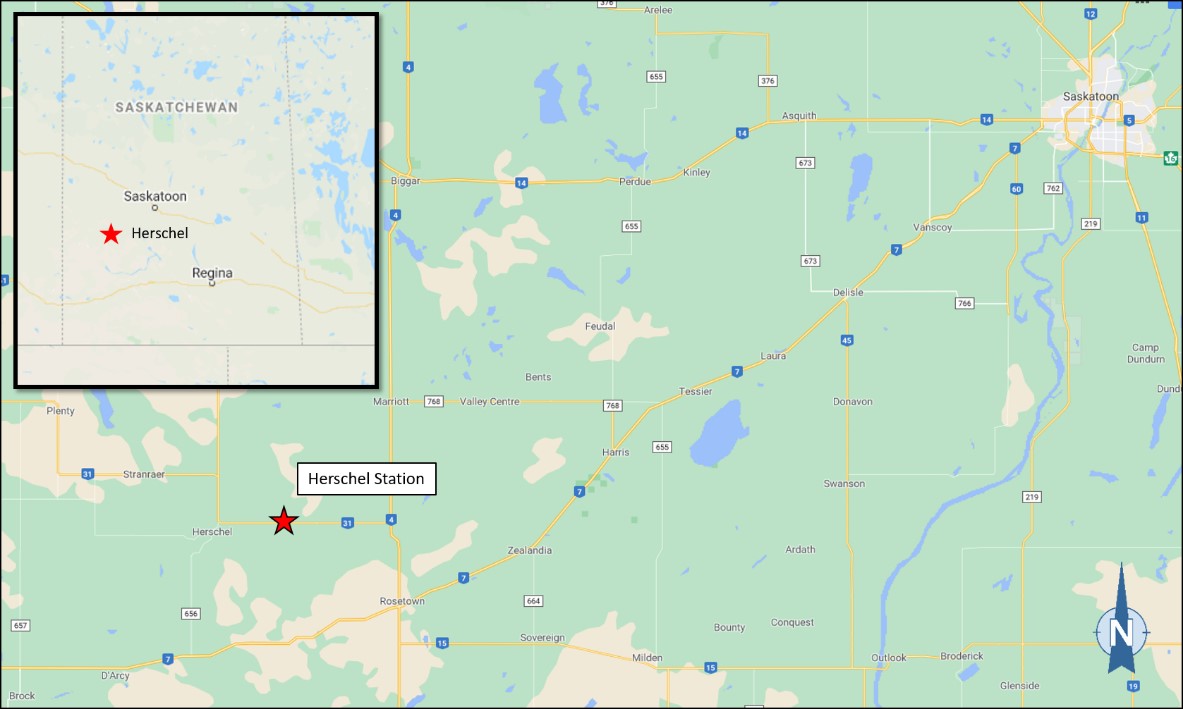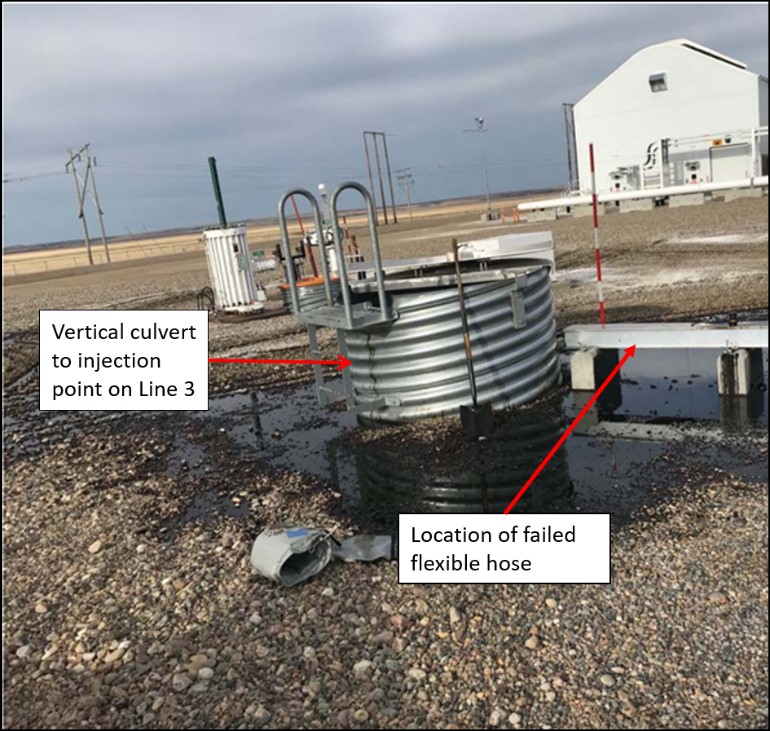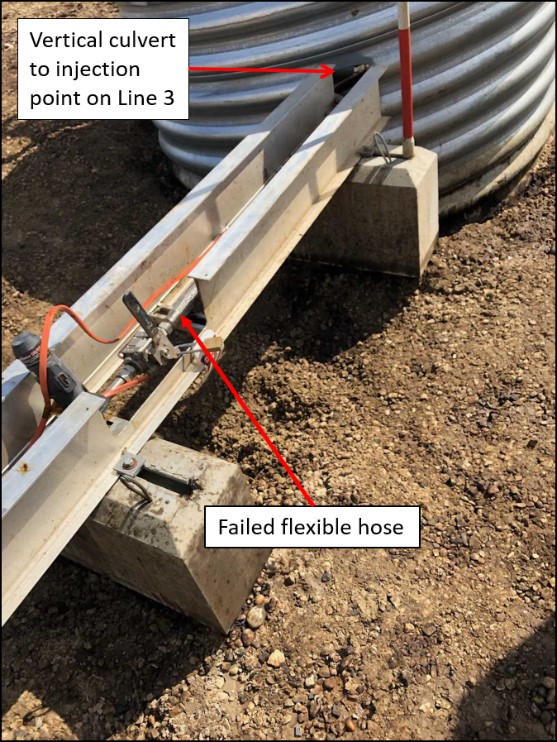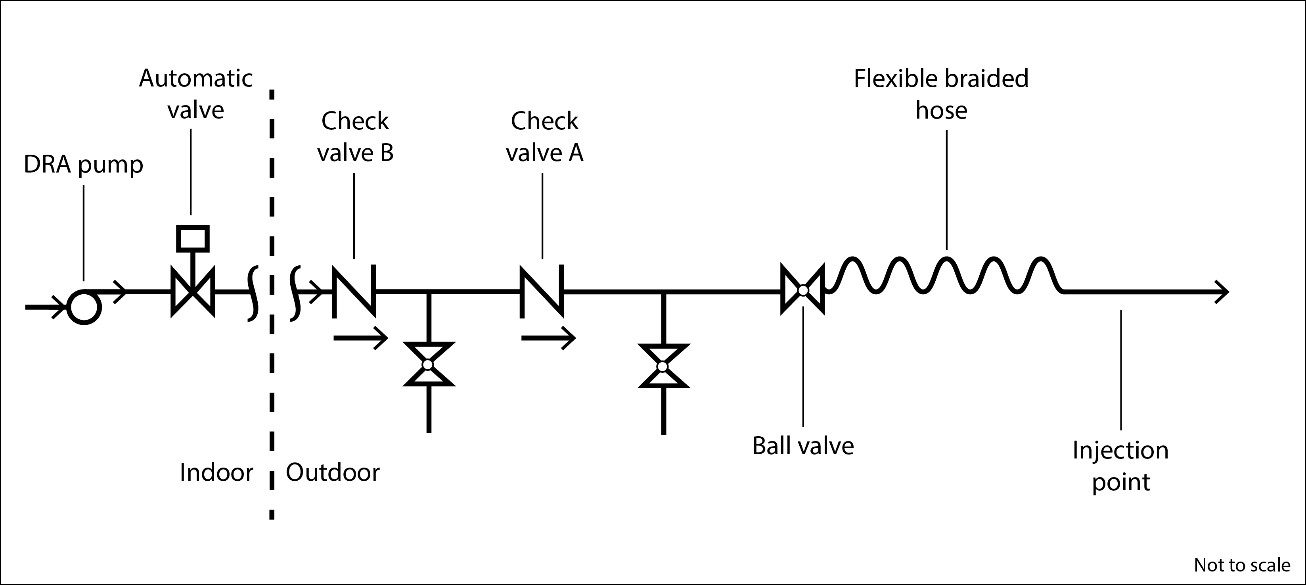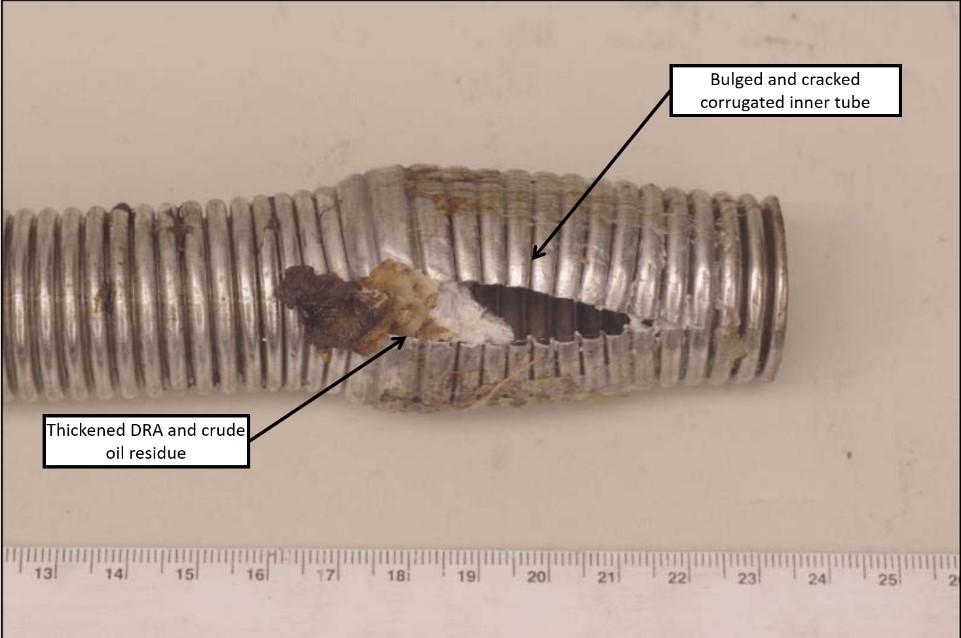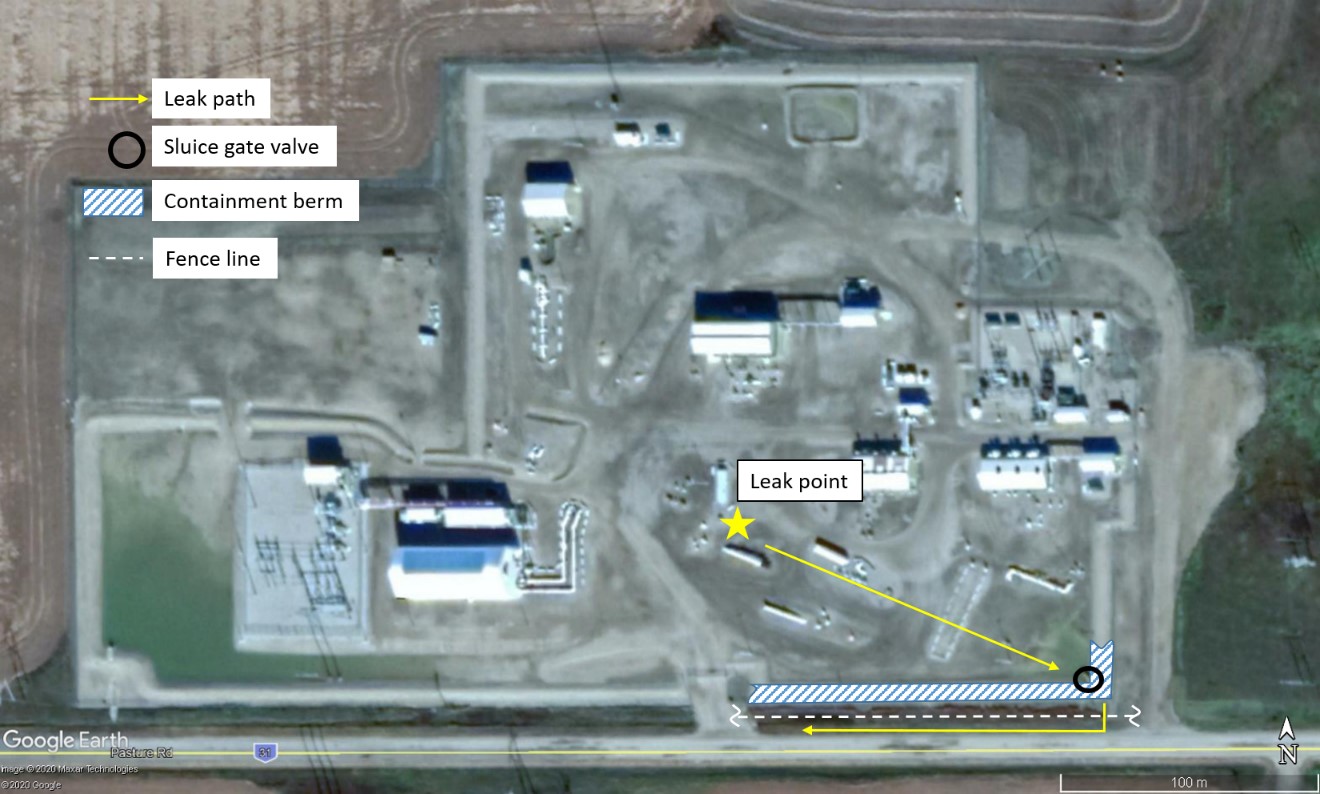Release of crude oil incident
Enbridge Pipelines Inc.
Herschel pump station
Near Herschel, Saskatchewan
The Transportation Safety Board of Canada (TSB) investigated this occurrence for the purpose of advancing transportation safety. It is not the function of the Board to assign fault or determine civil or criminal liability. This report is not created for use in the context of legal, disciplinary or other proceedings. See Ownership and use of content. Masculine pronouns and position titles may be used to signify all genders to comply with the Canadian Transportation Accident Investigation and Safety Board Act (S.C. 1989, c. 3).
The occurrence
On 30 April 2020 at approximately 0720,Footnote 1 a release of crude oil was discovered from an above-ground ¾‑inch flexible braided hose within the Enbridge Pipelines Inc. (Enbridge) Herschel pump station near Herschel, Saskatchewan (Figure 1). The source of the release was isolated at 0755. There were no injuries and no evacuation was required.
Herschel pump station
The Herschel pump station, commissioned in 1972, is located near Herschel, Saskatchewan, and services Enbridge’s Lines 1, 2, 3, 4, 13, 67, and 93, all of which are regulated by the Canada Energy Regulator (CER). The Line 3 pipeline is part of Enbridge’s mainline system and transports Western Canadian crude oil to markets in eastern Canada and the U.S. Midwest.
The Herschel pump station is monitored and controlled 24 hours a day by Enbridge’s operation control centre in Edmonton, Alberta. The week of the occurrence (27 to 30 April 2020), Enbridge field operation personnel were present at the pump station during the hours of 0700 to 1630.
That week, the temperature cycled from below freezing at night to above freezing during the day.
Site examination
The crude oil released from a ¾-inch flexible braided hose that is part of an above-ground auxiliary system used to inject drag reducing agents (DRA)Footnote 2 into Enbridge’s NPSFootnote 3 34 Line 3 pipeline (Figures 2 and 3).
An estimated 50 m3 of crude oil was released,Footnote 4 with approximately 10 m3 migrating off company property into a roadway ditch next to the station.
The crude oil migrated off site through an open drainage valve, which is used to drain accumulated storm water, from the station into an adjacent ditch.
During site cleanup, all of the released product was recovered.
Drag reducing agent injection system
Enbridge uses DRA injection systems at 2 pump stations on Line 3. The system at Herschel pump station was installed in 2016. It is housed in a heated building and consists of tanks to store DRA product, agitators, electrical subsystems, pumps, and other associated control hardware and piping.
The outlet piping from this building (Figure 4) includes ¾-inch stainless steel tubing and a flexible braided hose that run inside a support tray to the injection point in the Enbridge Line 3 pipeline. The outlet piping is also fitted with electrical heat tracing and thermal insulation to keep the piping system above a set temperature. This way, if DRA product remains stagnant, the piping system temperature is maintained above the freezing point.
The outlet piping also contains a check valve (marked as “check valve A” in Figure 4) upstream of the ¾-inch flexible braided hose. It prevents the backflow of crude oil from the Line 3 pipeline into the DRA injection system. In this design, it is possible for crude oil to backflow from the Line 3 pipeline through the ¾-inch flexible braided hose and up to check valve A.
At the time of the occurrence, the DRA injection system was not in use. The indoor portion of this system had been isolated at the automatic valve by the Enbridge operation control centre on 30 April 2018 and it had remained isolated ever since. In this operating state, the piping downstream of the automatic valve remains full of DRA, thereby ensuring that the DRA injection system remains ready for use when needed.
Following the occurrence, Enbridge noted that there had been a failure within the heat tracing system’s electrical controller.
Failure analysis of the ¾-inch flexible braided hose
The ¾-inch flexible braided hose was removed and sent to an independent engineering laboratory for a detailed examination. A bulge and a crack about 5 cm long were found on the hose’s corrugated inner tube, which is made of type 316L stainless steel. The crack was along the longitudinal weld centreline, in the section of tubing next to the ball valve. At the location of the bulge, the hose was plugged with a semi-solid material that was thickened DRA and crude oil residue (Figure 5). It is likely that freezing occurred when the heat tracing system malfunctioned.
The examination determined that no material anomaly caused the failure of the flexible braided hose; however, significant neckingFootnote 5 had occurred due to plastic deformation in the hoop direction prior to fracture. It was concluded that the crack initiated due to an instantaneous ductile fracture at the weld of the 316L stainless steel braided hose.
Release detection system
Enbridge’s release detection strategy encompasses multiple detection methods, including instrument-based monitoring, computational systems, and visual surveillance.
For small leaks in above-ground small-boreFootnote 6 piping systems, and specifically the type of piping in this occurrence, the primary method of detection is visual surveillance. Visual inspections are conducted by on-site operators or by Enbridge’s aerial and ground pipeline patrols. For leak sizes below the detectable limit of the computational systems and when the site is unattended by field personnel, Enbridge relies primarily on third-party reporting of a leak at this station.
On 29 April 2020, Enbridge field operators did not observe any leaking components before leaving the site at the end of the day, at approximately 1600. On that day, Line 3 at the Herschel pump station was in a scheduled shutdown. Later that evening, as part of the operating plan, Enbridge’s operations control centre in Edmonton restarted the Line 3 pipeline at approximately 2146 and shut it down again at approximately 2305. No abnormal conditions were observed during this start-up or shutdown.
When field operators arrived on site the next morning, they discovered the release from the ¾-inch flexible braided hose.
Herschel pump station containment system
The Herschel pump station is designed with a network of ditches, culverts, berms, and control valves on the Enbridge property. The station also comprises 3 containment ponds that have the combined capacity to hold approximately 13 000 m3 of liquid product. All of these items work together to contain liquid product and minimize off site impacts in the event of a release on the pump station site.
Containment proceduresFootnote 7 at the Herschel pump station also take into consideration the management of the storm water that can accumulate at the pump station, to ensure that storm water can be discharged without adversely affecting the environment. Enbridge requires storm water to be discharged as often as practical to maximize the containment capacity in the event of an unintended product release in the facility. According to Enbridge procedures, storm water discharge control valves must remain closed at all times unless they are actively discharging.
At the southeast corner of the Herschel pump station, storm water that accumulates in the containment berm is discharged by way of a sluice gate valve.Footnote 8 On 29 April 2020, this valve was manually opened to drain accumulated storm water. The valve was inadvertently left open at the end of the operators’ shift. As a result, the crude oil released from the ¾-inch flexible braided hose into the containment berm and was released into the roadway ditch off site (Figure 6).
Enbridge’s procedure for the discharge of storm water off site requires that a formFootnote 9 be completed every time. In this occurrence, the form was not completed when storm water was discharged on 29 April 2020.
Enbridge’s storm water discharge procedure does not include detailed instructions on the operation of discharge valves, including when to open and close each valve.
Hazard assessment of the drag reducing agent injection system
Before the DRA injection system was installed at the Herschel pump station, Enbridge performed a Hazard and Operability Study (HAZOP) and Layer of Protection Analysis (LOPA) as part of its risk management process.
The HAZOP identified heat tracing system malfunctions as a process hazard, which would expose the DRA injection system piping (including the ¾-inch flexible braided hose) to low temperatures. The HAZOP further identified, as a possible consequence of this hazard, that the piping or flexible braided hose could freeze, creating a blocked flow which would overpressure the piping and flexible braided hose, resulting in loss of containment of DRA.
However, the HAZOP did not identify that the design of the DRA injection system piping allows crude oil to backflow from the injection point to the check valve. Consequently, it also did not identify that, should the piping, including the ¾-inch flexible braided hose, freeze and rupture, there could be a release of crude oil. Therefore, no control measures were implemented to prevent crude oil from being released due to a failure of either the piping or the ¾-inch flexible braided hose.
Environmental impact of the release of crude oil
The released product was recovered, including the affected off-site soils. The affected soils were treated at an approved facility. The soil and groundwater sampling and monitoring performedFootnote 10 by Enbridge after the occurrence indicated that there was no significant impact to water or wildlife.
Safety action taken
Enbridge has evaluated the need for DRA injection systems and is taking action to isolate the systems that are no longer required.
Following the occurrence, Enbridge initiated a review of its storm water management procedures and documentation to identify areas for improvements. Enbridge also
- developed procedures for flushing intermittently operated DRA injection systems to prevent blockages and freezing;
- revised the design standard for DRA injection systems to ensure the check valve is located downstream of the flexible braided hose; and
- revised the preventative maintenance procedures for DRA injection systems and their components.
Safety message
In order to effectively manage the risks related to auxiliary piping systems, hazards associated with all operating conditions, including the backflow of crude oil, must be identified, evaluated and mitigated.
Furthermore, when procedures for discharging storm water from containment ponds do not clearly include all steps required to complete the task, a critical step may be missed, resulting in an unintended release of liquid hydrocarbons off site.
This report concludes the Transportation Safety Board of Canada’s investigation into this occurrence. The Board authorized the release of this report on . It was officially released on .
